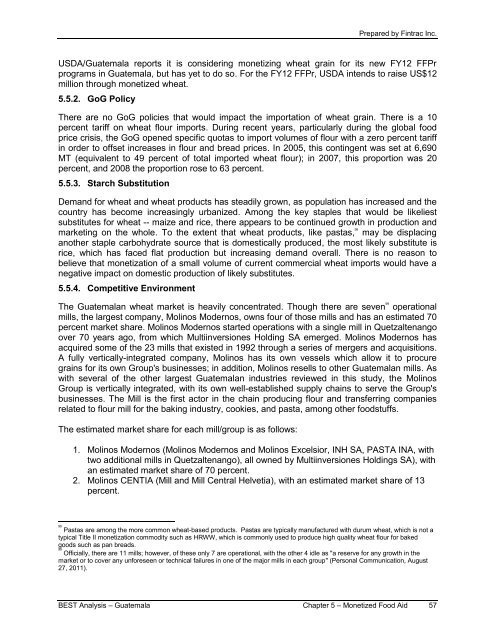usaid office of food for peace guatemala bellmon estimation
usaid office of food for peace guatemala bellmon estimation
usaid office of food for peace guatemala bellmon estimation
Create successful ePaper yourself
Turn your PDF publications into a flip-book with our unique Google optimized e-Paper software.
Prepared by Fintrac Inc.<br />
USDA/Guatemala reports it is considering monetizing wheat grain <strong>for</strong> its new FY12 FFPr<br />
programs in Guatemala, but has yet to do so. For the FY12 FFPr, USDA intends to raise US$12<br />
million through monetized wheat.<br />
5.5.2. GoG Policy<br />
There are no GoG policies that would impact the importation <strong>of</strong> wheat grain. There is a 10<br />
percent tariff on wheat flour imports. During recent years, particularly during the global <strong>food</strong><br />
price crisis, the GoG opened specific quotas to import volumes <strong>of</strong> flour with a zero percent tariff<br />
in order to <strong>of</strong>fset increases in flour and bread prices. In 2005, this contingent was set at 6,690<br />
MT (equivalent to 49 percent <strong>of</strong> total imported wheat flour); in 2007, this proportion was 20<br />
percent, and 2008 the proportion rose to 63 percent.<br />
5.5.3. Starch Substitution<br />
Demand <strong>for</strong> wheat and wheat products has steadily grown, as population has increased and the<br />
country has become increasingly urbanized. Among the key staples that would be likeliest<br />
substitutes <strong>for</strong> wheat -- maize and rice, there appears to be continued growth in production and<br />
marketing on the whole. To the extent that wheat products, like pastas, 98<br />
may be displacing<br />
another staple carbohydrate source that is domestically produced, the most likely substitute is<br />
rice, which has faced flat production but increasing demand overall. There is no reason to<br />
believe that monetization <strong>of</strong> a small volume <strong>of</strong> current commercial wheat imports would have a<br />
negative impact on domestic production <strong>of</strong> likely substitutes.<br />
5.5.4. Competitive Environment<br />
The Guatemalan wheat market is heavily concentrated. Though there are seven 99<br />
operational<br />
mills, the largest company, Molinos Modernos, owns four <strong>of</strong> those mills and has an estimated 70<br />
percent market share. Molinos Modernos started operations with a single mill in Quetzaltenango<br />
over 70 years ago, from which Multiinversiones Holding SA emerged. Molinos Modernos has<br />
acquired some <strong>of</strong> the 23 mills that existed in 1992 through a series <strong>of</strong> mergers and acquisitions.<br />
A fully vertically-integrated company, Molinos has its own vessels which allow it to procure<br />
grains <strong>for</strong> its own Group's businesses; in addition, Molinos resells to other Guatemalan mills. As<br />
with several <strong>of</strong> the other largest Guatemalan industries reviewed in this study, the Molinos<br />
Group is vertically integrated, with its own well-established supply chains to serve the Group's<br />
businesses. The Mill is the first actor in the chain producing flour and transferring companies<br />
related to flour mill <strong>for</strong> the baking industry, cookies, and pasta, among other <strong>food</strong>stuffs.<br />
The estimated market share <strong>for</strong> each mill/group is as follows:<br />
1. Molinos Modernos (Molinos Modernos and Molinos Excelsior, INH SA, PASTA INA, with<br />
two additional mills in Quetzaltenango), all owned by Multiinversiones Holdings SA), with<br />
an estimated market share <strong>of</strong> 70 percent.<br />
2. Molinos CENTIA (Mill and Mill Central Helvetia), with an estimated market share <strong>of</strong> 13<br />
percent.<br />
98<br />
Pastas are among the more common wheat-based products. Pastas are typically manufactured with durum wheat, which is not a<br />
typical Title II monetization commodity such as HRWW, which is commonly used to produce high quality wheat flour <strong>for</strong> baked<br />
goods such as pan breads.<br />
99<br />
Officially, there are 11 mills; however, <strong>of</strong> these only 7 are operational, with the other 4 idle as "a reserve <strong>for</strong> any growth in the<br />
market or to cover any un<strong>for</strong>eseen or technical failures in one <strong>of</strong> the major mills in each group" (Personal Communication, August<br />
27, 2011).<br />
BEST Analysis – Guatemala Chapter 5 – Monetized Food Aid 57

















